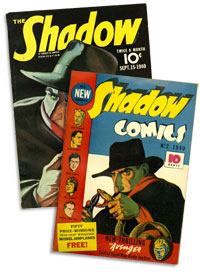 Many pulp characters have become comic book characters (in some cases, under different names, something I think is also unknown to many); and many comic book characters (especially the earlier ones) were inspired by pulp characters.
Many pulp characters have become comic book characters (in some cases, under different names, something I think is also unknown to many); and many comic book characters (especially the earlier ones) were inspired by pulp characters.
If they are wearing a suit and hat (example: the original Sandman, The Spirit, the original Crimson Avenger, etc.), they were inspired by pulp characters.
In recent years, there seems to have been a revival in pulp-inspired comic book characters. Sadly, most have not been faithful to the original material. But that’s not the focus of this post. (We’ll get to that subject in a future posting.)
Part of the reason for the pulp-comics connection is that most pulp publishers were actually part of larger companies that also published comic books — and often many other types of magazines, and sometimes books as well.
Most pulp collectors are aware of this, but most comic book collectors aren’t. They probably think most comic book publishers prior to recent decades (with DC now part of Warner Bros., and Marvel Comics recently being bought by Disney) were stand alone concerns. Since the companies sometimes didn’t have the same names, this is understandable, but just not so.
And this last point can make things confusing, such as when publishers often in the early part of the 20th century would operate under different names. Sometimes they formed new companies as prior ones went under. More confusing is when they operated multiple companies at the same time, for various reasons, some not so innocent. This was sometimes done to protect the overall company should a title fail, but sometimes also to defraud creditors and others.
In this post, I try to show the connections between early pulp and comic book concerns, as a way of educating people.
So, then, in no particular order…
Dell
Dell Publishing was formed by George Delacourt in 1921, and published pulps, magazines, and books. In the area of magazines, it did the whole gamut: slicks, pulps, and others. The Dell Magazine name continues today as a publisher of puzzle magazines.
Dell got into paperback books in 1943, and also had other imprints like Dial Press, Laurel Leaf, and Delacourt Press. Today the book concern is part of Random House.
Comics had an interesting history. Dell published its own comics from 1929 to 1936, after which it went into partnership with Western Publishing, with Dell basically putting its name on comics produced and printed by Western. This partnership ended in 1962, at which point Dell was back to producing its own comics for another 10 years before ending that effort.
Thrilling/Nedor
This one is a little confusing. While most pulp fans refer to the pulps as “Thrilling” and comic book fans refer to the comics as “Nedor,” neither of those were the actual name of the company. Many pulp fans know of the connection between the two; while I’ve seen a few comic fans who when finding out the connection would refer to the pulps as Nedor as well.
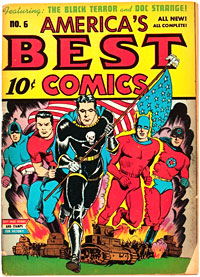 Ned Pines established Pines Publishing in 1921. He would publish pulps under the name Thrilling Publications, but the actual publisher name was Beacon (1936-37), Better (1937-1943) and then Standard (1943-55), at which point Pines shutdown his pulps.
Ned Pines established Pines Publishing in 1921. He would publish pulps under the name Thrilling Publications, but the actual publisher name was Beacon (1936-37), Better (1937-1943) and then Standard (1943-55), at which point Pines shutdown his pulps.
The comics went through a similar process, with Standard Comics being the parent company of Better and Nedor. This lasted from 1936 to 1949, when all the comics came under the Standard Comics brand. Standard Comics ended in 1956, after which Pines started a new Pines Comics, which lasted until 1959.
As we know, several pulp heroes were published by Thrilling (Phantom Detective, Black Bat, Captain Future, and many more). Several of those characters, some under new names, would appear as comic book characters in Nedor Comics.
Before the demise of the pulp and comics, Pines would start the paperback publisher Popular Library (which had a pine tree logo) in 1942, and would later devote his time to that line. It actually reprinted the Captain Future stories published by Thrilling, and would later merge with Fawcett (another old comic/magazine/book publisher) in 1970.
Street & Smith
The big daddy of pulp publishers during its day, Street and Smith also published books under the Chelsea House name and comic books. Begun in 1855, Street published comic book from 1940-49 (which included many of its pulp characters), and shutdown both its pulps and comics in 1949. It was bought out in 1959 by Conde Nast, which owns the rights to these characters.
Ace
A.A. Wyn‘s Ace Magazines (also known as Periodical House and Magazine Publishers) started in the 1930s as a pulp publisher. It branched out as Ace Comics from 1940-56, and into books in the 1940s.
In 1955, Ace Books was formed, and the pulps and comics were dumped. Ace became a major publisher of science fiction, being the place that the American edition of the German SF character Perry Rhodan was published. In the 1970s Ace would be bought out by Berkley, now the Penguin group.
DC
Most comic book fans don’t realize that DC Comics was actually formed from the merger of several early comic book companies, such as National Allied, Detective Comics and Max Gaines‘ All American Comics. And this concern was bought out by Harry Donenfeld, who published pulp magazines under various names, such as DM Magazines, Trojan, Culture, Speed and more. Donenfeld was the publisher of the “Spicy” pulps!
Donenfeld also owned Independent News, a major distributor, and had stakes in a rival comic book company, American Comics Group, that existed from 1943 to ’67.
Martin Goodman
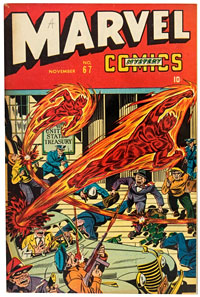 Most everyone knows of Marvel Comics, but few know of the man behind Marvel (and I don’t mean Stan Lee): Martin Goodman. Goodman got into the early days of pulp/comic book publishing along side some of the founders of MLJ/Archie and DC. And he followed the early style of creating a lot of shell companies under which he operated for decades.
Most everyone knows of Marvel Comics, but few know of the man behind Marvel (and I don’t mean Stan Lee): Martin Goodman. Goodman got into the early days of pulp/comic book publishing along side some of the founders of MLJ/Archie and DC. And he followed the early style of creating a lot of shell companies under which he operated for decades.
He published pulps under a variety of names, including Red Circle, Manvis and others. He got into comics early on, forming Timely Comics. Later it was more or less named Atlas, to coincide with his distributing business, Atlas Distributors.
When pulps started to die out, he formed Magazine Management Co., and published a lot of magazines, including many men’s adventure magazines while also publishing Marvel Comics. What is interesting is that Marvel’s black-and-white magazines from the ’70s were actually published under the Magazine Management banner.
Lesser known by many are his adult magazines.
MLJ
Most people may not be aware of this early comic book publisher, knowing it better under the name it later took on: Archie Comics.
MLJ was named for the three founders of the company: Maurice Coyne, Louis Silberkleit and John L. Goldwater. Coyne and Silberkleit were also involved with Columbia Publishing, a minor pulp firm that was around until the ’50s. Goodman was apparently also involved with Columbia, but left early on. I think Coyne and Silberkleit were also involved in Goodman’s Red Circle pulp company, but I’m not certain.
It was due to these connections that Columbia would publish the pulp stories of MLJ’s top selling character, the Black Hood. And I’ve always wondered why Archie Comics in later years used the name Red Circle Comics to put out very non-Archie comics, and have to think it took the name from Goodman’s old pulp company, maybe as a slap against his Marvel Comics.
In later years, MLJ had a paperback company called Belmont Books in the 1960s. This is why new Shadow novels were coming from Belmont, while new Shadow comics were coming from Archie.
Fawcett Publications
Most people know Fawcett for the comic book character Captain Marvel. Again, less known was that Fawcett was a publishing concern that included a wide variety of magazines as well as books. It was formed in 1919, and continued until being bought out by CBS Publications in 1977 (yes, that’s the TV broadcaster).
Most people know of the comic books, and most think it stopped published comic books with the demise of Captain Marvel in the 1950s. It actually returned to publishing comics in the 1960s, and would continue to do so until around 1980.
It formed the Gold Medal paperback concern, and would later buy Pines’ Popular Library in 1970.
Popular Publications
Harry Steeger‘s Popular Publications (1930-60) never got into books or comics. It stayed a pure pulp publisher. But, from the papers that were submitted to a library (don’t recall which), there’s apparently information on proposed comic books. Wish some researcher would look into it. The rights to its works are now held by Argosy Communications. Popular did have a few other imprints. One was Fictioneer, which was created to have a separate line that actually paid half of what Popular was paying.
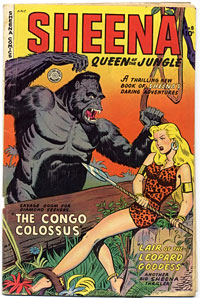 Fiction House
Fiction House
Another smaller publisher which did both pulps and comics, Fiction House existed for a couple of decades, going under in the 1950s. Many of its pulp magazines and comics shared similar titles. The main claim to fame is Sheena, who starred for years in her own comic book, then later got a pulp of her own for a few issues. (That’s a rare example of a comic book character becoming a pulp character.)
Munsey
The Frank A. Munsey Co. was the first pulp publisher. It also used the name Red Star. It never got into comics, but was still publishing in the 1940s when the company shutdown and sold off its rights to Popular.
Ziff-Davis
Another long-running company, Ziff-Davis was formed in 1927, and still exists today as a publisher of computer-related magazines and online tech media.
They did get into pulps, mainly aviation and science-fiction, and briefly published comics, but never got into superheroes. So no pulp heroes from them.
So there are some of the major pulp/comic book publishers. I hope this information is of interest to others. I recommend you check out the pages at Wikipedia, where I took some of this information from.

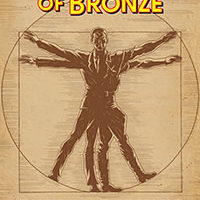
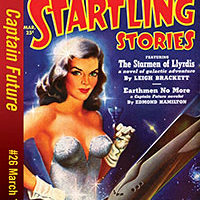
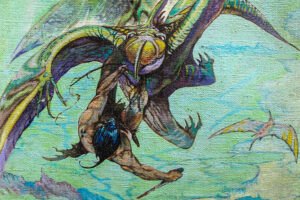
Always enjoy the Super Fan articles! Very informative and well written.
That is Harry Donenfeld, not Donenfield.
Thanks. Will fix that.